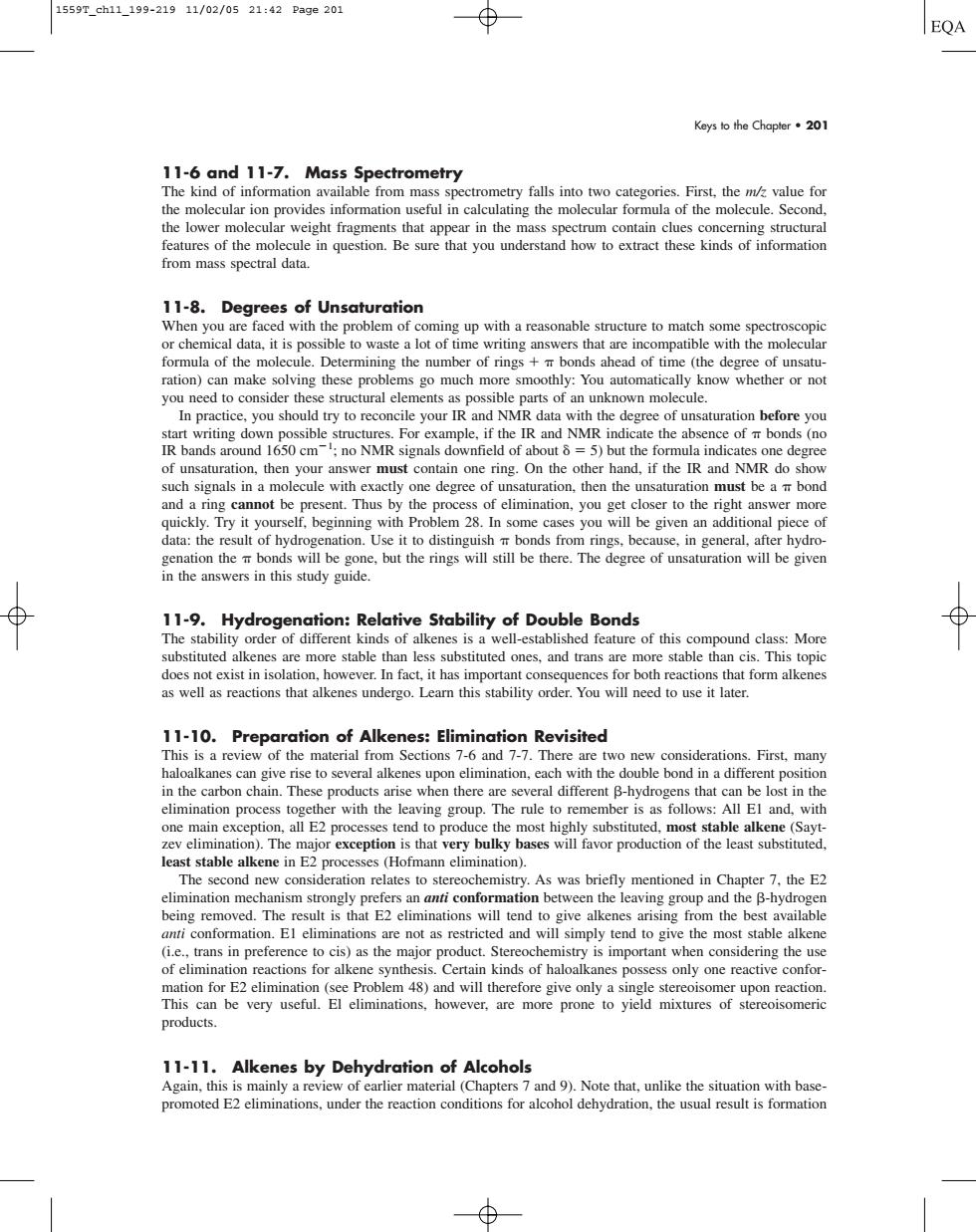正在加载图片...

15597ch11199-21911/02/0521:42Pag0201 EQA Keys o the Chapter·201 11-6 and 11-7. Mass Spectror netry falls int 11-8.De ree ration up with a reasonable structure to match formula of the mole ning the numbe of rings+bon In practice,you should try to reconcile your IR and NMR data with the degree of unsaturation before you of unsaturation,then your answer must contain one ring.On the other hand,if the IR and NMR do shov signa n a molecule with exac y one degree of n,then th be a bon Trone begining h pbIn me celbehen pie sult of u give in the answers in this study guide. stablished feature of this compound class:Mon 心心 form alkene 11-10.Pr eparation of Alkenes: Revisited in the carbon chain.The in th one main e e the most highly substituted.most stable alkene (Say eliminatio n).The major exception is that very bulky bases will favor production of the least substituted was bricfly mentioned in Chanter 7.the E2 elimination mechanism strongly prefers ani conformation between the leaving group and the B-hydroger eing removed Et is to give alken m the be Ge.trans in preference to cis)as the maior product.Stereochemistr is important when considering the use For E2 reactions for alke Cert inds of haloa nes po sess only one reactive conto products. 11-11.Alkenes by Dehydration of Alcohols Again,thiKeys to the Chapter • 201 11-6 and 11-7. Mass Spectrometry The kind of information available from mass spectrometry falls into two categories. First, the m/z value for the molecular ion provides information useful in calculating the molecular formula of the molecule. Second, the lower molecular weight fragments that appear in the mass spectrum contain clues concerning structural features of the molecule in question. Be sure that you understand how to extract these kinds of information from mass spectral data. 11-8. Degrees of Unsaturation When you are faced with the problem of coming up with a reasonable structure to match some spectroscopic or chemical data, it is possible to waste a lot of time writing answers that are incompatible with the molecular formula of the molecule. Determining the number of rings bonds ahead of time (the degree of unsaturation) can make solving these problems go much more smoothly: You automatically know whether or not you need to consider these structural elements as possible parts of an unknown molecule. In practice, you should try to reconcile your IR and NMR data with the degree of unsaturation before you start writing down possible structures. For example, if the IR and NMR indicate the absence of bonds (no IR bands around 1650 cm1 ; no NMR signals downfield of about 5) but the formula indicates one degree of unsaturation, then your answer must contain one ring. On the other hand, if the IR and NMR do show such signals in a molecule with exactly one degree of unsaturation, then the unsaturation must be a bond and a ring cannot be present. Thus by the process of elimination, you get closer to the right answer more quickly. Try it yourself, beginning with Problem 28. In some cases you will be given an additional piece of data: the result of hydrogenation. Use it to distinguish bonds from rings, because, in general, after hydrogenation the bonds will be gone, but the rings will still be there. The degree of unsaturation will be given in the answers in this study guide. 11-9. Hydrogenation: Relative Stability of Double Bonds The stability order of different kinds of alkenes is a well-established feature of this compound class: More substituted alkenes are more stable than less substituted ones, and trans are more stable than cis. This topic does not exist in isolation, however. In fact, it has important consequences for both reactions that form alkenes as well as reactions that alkenes undergo. Learn this stability order. You will need to use it later. 11-10. Preparation of Alkenes: Elimination Revisited This is a review of the material from Sections 7-6 and 7-7. There are two new considerations. First, many haloalkanes can give rise to several alkenes upon elimination, each with the double bond in a different position in the carbon chain. These products arise when there are several different -hydrogens that can be lost in the elimination process together with the leaving group. The rule to remember is as follows: All E1 and, with one main exception, all E2 processes tend to produce the most highly substituted, most stable alkene (Saytzev elimination). The major exception is that very bulky bases will favor production of the least substituted, least stable alkene in E2 processes (Hofmann elimination). The second new consideration relates to stereochemistry. As was briefly mentioned in Chapter 7, the E2 elimination mechanism strongly prefers an anti conformation between the leaving group and the -hydrogen being removed. The result is that E2 eliminations will tend to give alkenes arising from the best available anti conformation. E1 eliminations are not as restricted and will simply tend to give the most stable alkene (i.e., trans in preference to cis) as the major product. Stereochemistry is important when considering the use of elimination reactions for alkene synthesis. Certain kinds of haloalkanes possess only one reactive conformation for E2 elimination (see Problem 48) and will therefore give only a single stereoisomer upon reaction. This can be very useful. El eliminations, however, are more prone to yield mixtures of stereoisomeric products. 11-11. Alkenes by Dehydration of Alcohols Again, this is mainly a review of earlier material (Chapters 7 and 9). Note that, unlike the situation with basepromoted E2 eliminations, under the reaction conditions for alcohol dehydration, the usual result is formation 1559T_ch11_199-219 11/02/05 21:42 Page 201�